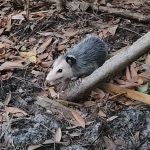Awesome Opossums

August 20, 2024 By Katie Roundtree
Virginia Opossums, the animal native to North America and, more specifically, Florida, is a misunderstood and one of nature’s more fascinating animals. It is the northernmost marsupial in the world and North America’s only marsupial. A female opossum gives birth to tiny, underdeveloped young opossums, who will grow up in the mother’s pouch for 8-10 weeks. Once the young emerge from the pouch, the offspring will remain with the mother, sometimes riding on her back, for another six weeks. This earns her one of her nicknames, “nature’s minivan.” Once weaned and ready to forage on their own, the mother will shake any remaining offspring off her back and move on to another area, leaving the young to continue on their own.
Opossums, as omnivores, play a crucial role in the ecosystem. They consume plants, insects and small animals, and are known to scavenge for food in trash cans, earning them the nickname “nature’s garbage man.” Their scavenging habits make them excellent clean-up crews, helping to keep the environment free of waste.
One of the most significant roles of opossums in the ecosystem is their ability to control pests and diseases. Their unique superpower is the ability to eat ticks, which can spread Lyme disease. Opossums can consume thousands of ticks each week, assisting to limit the spread of the disease. Their immunity to Lyme disease and their role as opportunistic scavengers that eat cockroaches, crickets, beetles, slugs, snails, snakes, and many others, make them an invaluable part of the natural world.

Another remarkable trait of opossums is their immunity to various toxins and venoms. They are resistant to honeybee stings, scorpions, botulism toxin, and even snake venom. In fact, they have partial or total immunity to the venom of pit vipers like rattlesnakes, copperheads, and water moccasins. This unique immunity, known to scientists since the 1940s, is being studied for potential medical applications, such as the development of a low-cost rattlesnake antivenom.
They are nearly impervious to rabies because their body temperature is too low to host the rabies virus. If you see an opossum who’s hissing, drooling or swaying, don’t panic and assume they’re rabid! Opossums use these bluff behaviors and play dead to outsmart potential predators.
Contrary to popular belief, opossums aren’t staging a dramatic play of their own demise. Instead, they enter a state called “tonic immobility,” which is a physiological response to extreme stress. An opossum playing dead will typically lie on its side with its eyes closed. Its breathing will get shallow and may even appear to stop completely. While they don’t spray like skunks, opossums smell when they play dead. Sometimes, the opossum will loll its tongue and drool, even excreting waste to exaggerate its catatonic-like state. These signs will usually convince a predator that the opossum is dead, and it will lose interest.
It’s important to note that the opossum and the possum are not the same animal. In North and South America, the animal is referred to as an opossum, while in Australia and other countries, it is called a possum. In North America, an opossum is a white and gray marsupial of the order Didelphimorphia. The word ‘opossum’ was derived from its equivalent in Powhatan, a language spoken by the Virginia Algonquian tribe, and it means ‘white dog or beast’ in Powhatan.
On the other hand, possums live in Australia, New Guinea, Sulawesi, New Zealand, and China. Their name does derive from opossum. Sir Joseph Banks, a British botanist, thought they looked enough like the American opossum to give them a similar name. However, kangaroos and other Australian marsupials are closer relations than American opossums. Possums belong to the Diprotodontia order.

Although they may look dangerous, opossums are relatively docile and harmless creatures. They have some fantastic superpowers that can help humans by limiting the spread of diseases and cleaning up trash left by other scavengers. Next time you see one, appreciate them for the amazing and fascinating creatures that they are.
